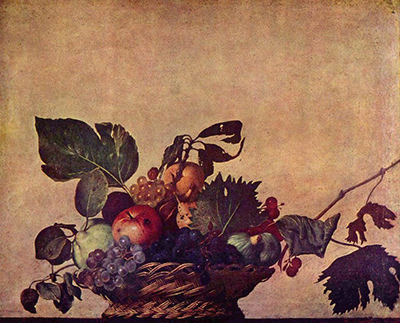Caravaggio's Basket of Fruit is a still life painting that is displayed in the Ambrosian Library in Milan.
The image is Caravaggio's depiction of a wicker basket containing a selection of summer fruit. The basket is situated on a ledge or shelf with a plain background. The fruit has remained a much debated element of the painting.
The fruit is in poor condition, it has been eaten in parts by insects and worms.
When this is considered with the era in which the painting was created the underlying theme seems to be fading beauty, and the acceptance that all things eventually decay.
Many scholars have drawn parallels between the church and the basket of fruit describing it as a metaphor for the decaying church.
There has been much disagreement about the date the painting was created. The earliest date that has been suggested is 1596, with others suggesting 1601 to be more likely. Every year in between these has been suggested.
The most likely date does seem to be 1601, for the basket of fruit is the same fruit that is used in another of Caravaggio's paintings the Supper at Emmaus.
Cardinal Federico Borromeo had the painting as part of his collection in 1607, which suggests the painting to have a reference to Amos. Borromeo was the Archbishop of Milan between 1597 and 1602 and a guest of Del Monte.
Borromeo had a great interest in European art such as Paul Bril who was also in Rome in this period. He particularly enjoyed the way that painters depicted flowers and landscapes and fruit as the main subjects of paintings.
This was not common at the time in Italian painting. Giustiniani, an Italian art scholar wrote a twelve scale register of treatise on painting, putting flowers and tiny things in fifth place.
He recalled, however, that Caravaggio had told him that it takes as much workmanship to complete a good painting of flowers as it did for him to paint a human being.




